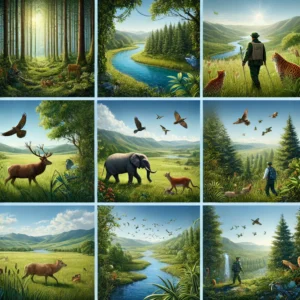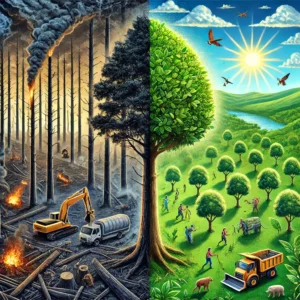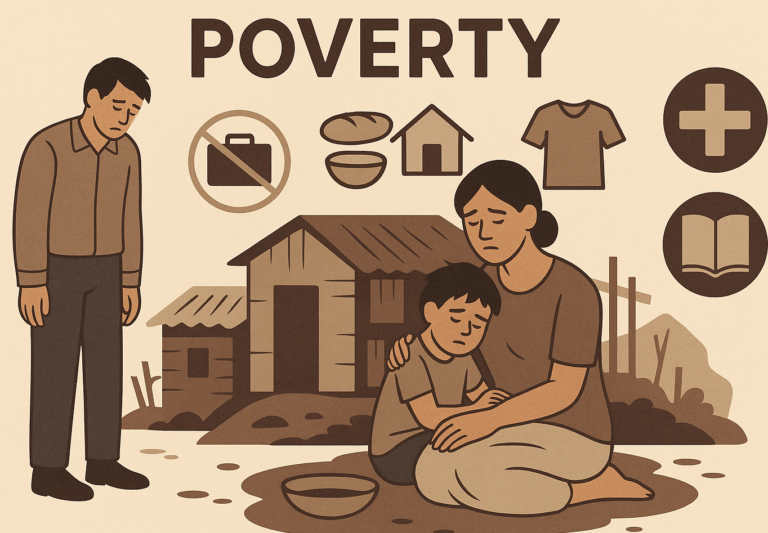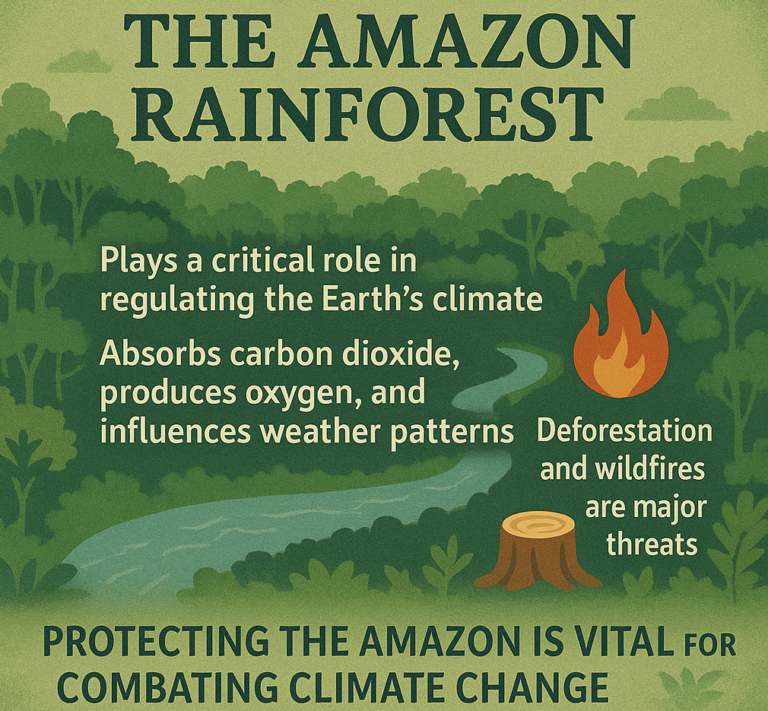1. Biodiversity
Biodiversity refers to the variety of life on Earth. It includes all living things—plants, animals, fungi, and microorganisms—and their different forms, such as species, genes, and ecosystems. It’s the variety and variety of life forms that make our planet rich and interesting.

- Why is Biodiversity Important?
- Ecosystem Balance: Each species plays a role in maintaining the balance of the ecosystem. For example, bees pollinate flowers, helping plants grow and produce food. Without them, many plants would not be able to reproduce.
- Human Survival: Biodiversity provides us with food, medicines, and other resources. For example, many of the medicines we use today come from plants and animals.
- Cultural Importance: Different species and ecosystems play a role in human culture, religion, and traditions.
Example: The Amazon Rainforest is known for its incredibly rich biodiversity, where thousands of species of plants, animals, and insects live, all interacting with each other.
2. Endangered Species
An endangered species is a species that is at risk of becoming extinct. This means that if the species continues to decline in number, it could disappear from the planet forever.
Why do species become endangered?
- Habitat Loss: When forests are cut down, or rivers are polluted, animals lose their homes. For example, tigers lose their forests and prey, making it harder for them to survive.
- Poaching and Illegal Hunting: Some animals are hunted for their skins, tusks, or other body parts, such as rhinos for their horns or elephants for their tusks.
- Climate Change: Changes in the climate, like rising temperatures or more severe weather, can destroy the habitats of many species. For instance, the polar bear is affected by melting ice in the Arctic, which makes it harder to find food.
- Invasive Species: Sometimes, non-native species are introduced into an ecosystem and compete with local species for resources. This can threaten the survival of native species.
Examples of Endangered Species:
- Tigers: There are only about 3,900 tigers left in the wild due to habitat loss and poaching.
- Asian Elephants: These elephants are at risk because of habitat destruction and illegal poaching for ivory.
- Giant Pandas: Pandas are endangered mainly due to habitat loss and their very specific diet of bamboo, which is becoming scarce.
3. Forests
Forests are large areas covered with trees and plants. They are one of the most important ecosystems on Earth. They provide food, medicine, and shelter for countless species, including humans.
Types of Forests:
- Tropical Rainforests: Found near the equator, these forests are hot, humid, and get a lot of rainfall. They are home to half of the world’s plant and animal species.
- Example: The Amazon Rainforest is the largest tropical rainforest and contains a huge variety of species, some of which have not even been discovered yet.
- Temperate Forests: These forests have four distinct seasons—spring, summer, autumn, and winter. They are found in regions with moderate rainfall and mild temperatures.
- Example: The temperate forests of North America are home to animals like bears, deer, and a wide variety of trees like oaks and pines.
- Boreal Forests (also known as Taiga): These forests are found in cold regions, especially in the northern parts of the world. They are mainly made up of coniferous trees like spruce and pine.
- Example: The Siberian Taiga in Russia is one of the largest forest areas in the world.
Why are Forests Important?
- Oxygen Production: Trees and plants in forests absorb carbon dioxide and release oxygen, which is essential for all living beings.
- Climate Regulation: Forests help regulate the climate by absorbing greenhouse gases and reducing the effects of global warming.
- Home for Animals: Many species, including endangered ones, depend on forests for food, shelter, and a safe place to live.
- Water Cycle: Forests help in the water cycle by absorbing and releasing water, which maintains rainfall patterns and prevents floods.
Threats to Biodiversity and Forests
- Deforestation: The clearing of forests for agriculture, logging, and urban development is a major threat to biodiversity. It destroys habitats, leaving species with nowhere to live.
- Example: The Amazon Rainforest is being destroyed at an alarming rate, affecting countless species that depend on it.
- Pollution: Pollution from factories, vehicles, and waste affects both land and water, harming plants, animals, and entire ecosystems.
- Example: Plastic pollution in the oceans is harming marine life, with animals like sea turtles mistaking plastic for food.
- Climate Change: Changing weather patterns, rising temperatures, and extreme events like floods or droughts make it difficult for species to survive in their natural habitats.
- Example: Polar bears are losing their ice habitats in the Arctic due to rising temperatures, affecting their ability to hunt and find food.
Conservation Efforts
Efforts to protect biodiversity and forests include:
- Protected Areas: Establishing national parks, wildlife sanctuaries, and reserves where animals and plants are safe from human activities.
- Anti-Poaching Laws: Governments are making stricter laws to prevent poaching and illegal hunting of animals like elephants, rhinos, and tigers.
- Reforestation: Planting trees to restore forests that have been cut down or damaged.
- Awareness and Education: Teaching people about the importance of biodiversity and encouraging eco-friendly practices like recycling and sustainable living.
Key Takeaways
- Biodiversity refers to the variety of life on Earth, including plants, animals, and ecosystems. It’s important for the balance of nature and human survival.
- Endangered species are at risk of extinction due to habitat loss, poaching, climate change, and more.
- Forests are vital ecosystems that provide oxygen, shelter for species, regulate the climate, and are essential to the water cycle.
- The main threats to biodiversity and forests include deforestation, pollution, and climate change.
- Conservation efforts, like creating protected areas and reforestation, are crucial to protecting biodiversity and forests.











